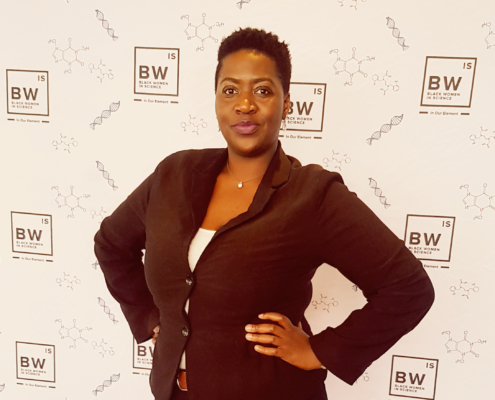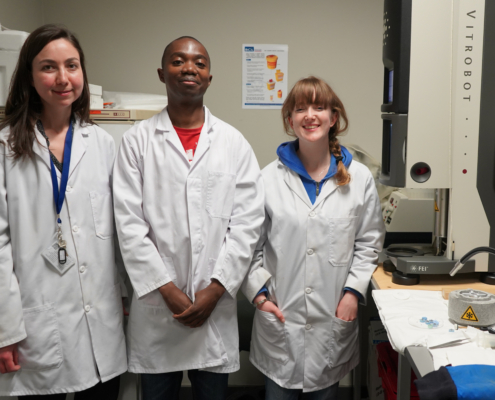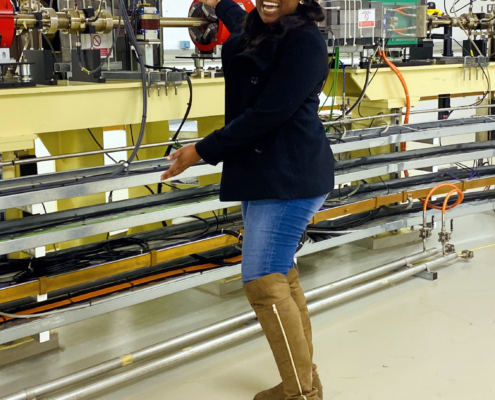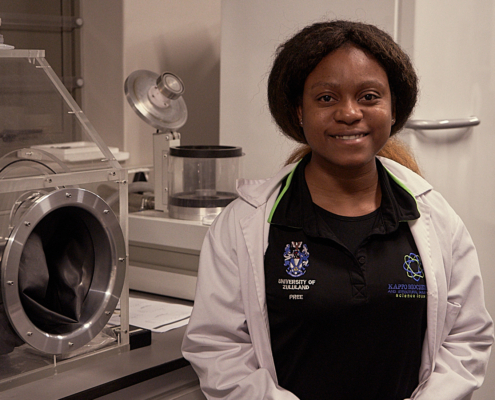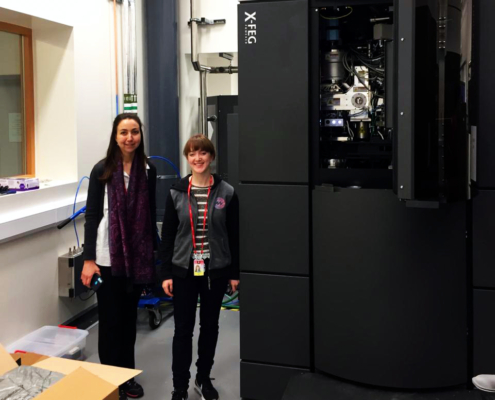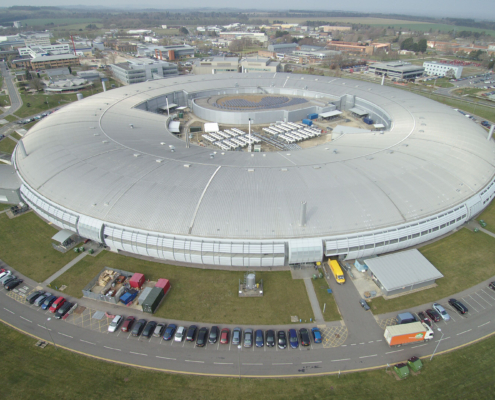Did you know that globally only 30% of science researchers are female?
And why collaborating with young female scientists in Africa is reaping great results .
Timed to coincide with UN International Day of Women and Girls in Science on 11 Feb, and to inspire more female students to study and work in science, the GCRF START grant has announced the results of its three year project launched in March 2019. To date it has directly collaborated with nearly 50 young African research students and given access to almost 100 synchrotron beamline sessions. Over half of START’s students are female scientists who are demonstrably changing perceptions and increasing the possibilities for women choosing long term STEM research careers.
“Globally UNESCO figures show that only 30% of researchers are female and they occupy only 20% of STEM leadership positions. These figures are even lower in many countries in Africa underlining how important it is to challenge women’s under-representation. Young female African scientists are vital both for their research and as role models and mentors for the next generation. So we are really delighted to see many of the young women we collaborate with through the START grant, making great strides and achieving some incredible results in the fields of structural biology and energy materials,” comments Prof. Chris Nicklin, Science Group Leader and Principal Investigator (PI) in the GCRF START (Synchrotron Techniques for African Research and Technology) grant programme.
Dr Priscilla Masamba has solved the partial structure of a protein from Schistosoma mansoni, a parasite responsible for the debilitating disease Schistosomiasis (Bilharzia) which is endemic in more than 78 countries, with an estimated 4 million people infected in South Africa alone. Her work will contribute to drug discovery efforts and is notable because she was the first student from the University of Zululand, South Africa, to use the Diamond synchrotron, which she did remotely from a lab in South Africa learning many scientific techniques for the first time;
Thandeka Moyo is part of a leading South African team working on HIV/AIDS vaccine research and is currently researching Covid-19; Originally from Zimbabwe, Thandeka mentors early career female scientists and is a role model for school children;
Gugulethu Nkala is investigating new generation renewable energy storage systems in South Africa to help close the energy poverty gap; she is active in inspiring girls into STEM;
Michelle Nyoni is studying energy materials to improve the performance of Lithium-ion batteries for portable electronics and renewable energy sources to make them affordable and improve their environmental footprint to tackle climate change. Michelle is a chemistry lecturer in Zimbabwe.
“The GCRF START grant has been a game-changer for young African scientists, particularly from under-represented groups such as female, and black scientists, enabling them to enter the fields of Structural Biology and Energy Materials and thrive,” says GCRF START Co-Investigator, Prof. Edward D. Sturrock from the University of Cape Town, South Africa.
One young scientist working with START, Gugulethu Nkala, is an Energy Materials PhD student from South Africa. The eldest of three daughters and first in her family to go to university, she remarks; “Seeing a black girl in science, makes girls see that there is someone, just like them, who has gone this far. We are breaking barriers that makes science seem unattainable, by being the link between science and society, made possible by funding bodies like the GCRF START grant.”
Access to inclusive quality education and lifelong learning opportunities is a distant dream for many young people across Africa, especially women. Few have the opportunity to finish school, let alone reach university to study world-class science, be mentored by experts or continue to postdoctoral studies. This can be due to lack of access to resources at home institutions, insufficient grant writing experience, lack of mentors or supervisors, inadequacy of facilities, and poor postdoctoral pay.
“It is important to support and mentor young women in science especially since women are largely under-represented, particularly in the case of the physical sciences, the field in which we work. I found that having access to synchrotrons and also building international collaborations through the GCRF START grant programme has not only allowed the young women that I work with to gain better skills but they also grow in confidence about their abilities,” says Professor Caren Billing, Energy Materials Research Group Co-Principal Investigator (Co-PI), Lecturer and Associate Professor in the School of Chemistry at the University of the Witwatersrand, South Africa.
The GCRF START grant supports young scientists working on key Climate, Energy, Health, and Education challenges in line with the UN’s Sustainable Development Goals by building partnerships between world leading scientists in Africa and the UK and enabling them to work together on research using synchrotron science. The project focuses on developing and characterising new energy materials, for example in the development of solar cells or improving energy efficiency through novel catalysts, and structural biology to understand diseases and develop drug targets for better treatments and potential vaccines. The START programme is grant-funded through the UK’s Global Challenges Research Fund (GCRF) and delivered by UK Research and Innovation (UKRI) through the Science and Technology Facilities Council (STFC) and the UK’s national synchrotron facility, Diamond Light Source.
United Nations | International Day of Women and Girls in Science – 11 February https://www.un.org/en/observances/women-and-girls-in-science-day/Messages “Science is a collaborative discipline. Yet science is being held back by a gender gap. Girls and boys perform equally well in science and mathematics – but only a fraction of female students in higher education choose to study sciences. To rise to the challenges of the 21st century, we need to harness our full potential. That requires dismantling gender stereotypes. It means supporting the careers of women scientists and researchers.” United Nations, Secretary General, Antonio Guterras
For further information please contact Diamond Communications: Lorna Campbell +44 7836 625999 or Isabelle Boscaro-Clarke +44 1235 778130
Dr Thandeka Moyo: https://start-project.org/2020/08/24/how-i-became-an-hiv-research-scientist-one-zimbabweans-story/ HIV research, working on HIV/AIDs vaccine research, and her desire to end HIV stigma plus her current mentoring of young female scientists, as well as her own successes in research. Dr Thandeka Moyo, GCRF START Postdoctoral Research Fellow at the South African National Institute for Communicable Diseases, is affiliated to the University of the Witwatersrand, South Africa. She says the GCRF START grant has given her opportunities she could have never imagined. “I now have access to a world-class synchrotron, the UK’s national synchrotron – Diamond Light Source, where I can send my HIV-antibody complexes to obtain the vital diffraction data I need for my research.” Thandeka is also highly active in mentoring young female scientists and encouraging the next generation of young women to pursue a career in academia and other science-related industries, with school outreach initiatives, involvement in student ‘shadowing’, as well as presentations to school children – currently over Zoom.
“It was like a cool Sci-Fi movie!” Priscilla’s story shows how giving access to cutting-edge synchrotron technology and inspiring, funding and training the next generation of Structural Biologists in Africa is vital. Priscilla’s research focus is to find new drug targets to treat Schistosomiasis (Bilharzia), a parasitic disease which impacts the health and livelihoods of many populations around the world. She is currently busy with the characterisation and structure determination of a protein known as Glycosyltranferase from Schistosoma mansoni, a protein secreted by the parasite’s tegument which holds promise as a potential, therapeutic candidate for Schistosomiasis. She is now a postdoc at the University of Johannesburg and will soon to be publishing a paper.
Priscilla achieved her PhD from the University of Zululand in 2020 – a historically under-resourced university in South Africa – after which she secured a bursary for a postdoctoral position at the University of Johannesburg. As a PhD student, Priscilla was the first University of Zululand student to use the UK’s national synchrotron, Diamond Light Source, made possible by the GCRF START grant, enabling her in 2020 to solve the partial structure of the G4LZI3 universal stress protein – a potential target for novel Schistosomiasis medicines. The unique collaboration between structural biologists at University of Cape Town (UCT) and the University of Zululand introduced by START Co-I, Prof. Trevor Sewell made possible through the GCRF START grant, provided Priscilla with sought after skills and the rare opportunity for access to Diamond for her experiments using state-of-the-art robotic technology at Diamond controlled remotely from a laboratory at UCT.
Gugulethu Nkala https://start-project.org/2021/01/26/breaking-barriers-and-aiming-high-an-african-woman-in-energy-materials-science-gugulethu-nkalas-story/ Gugu’s research on ‘The Use of Fused Bimetal Phosphate-based Ceramics for Solid-State Electrolyte Applications’ focuses on improving renewable energy storage systems to make them more efficient, affordable, safe, and environmentally friendly. Gugu’s motivation is to close the Energy poverty gap in sub-Saharan Africa where a large population, especially in the rural areas, is still without access to basic electricity, sanitation, and health care. Through the GCRF START grant, Gugu has visited the UK’s National synchrotron, Diamond Light Source, and gained essential research skills and networks. Actively involved in science outreach to impoverished schools, Gugu is enthusiastic about motivating and assisting young people from disadvantaged backgrounds to fulfil their dreams in the way she herself was encouraged. “Seeing a black girl in science, makes them see that there is someone, just like them, who has gone this far. We are breaking barriers that makes science seem unattainable, by being the link between science and society, made possible by funding bodies like the GCRF START grant,” says Gugu. A female Energy Materials PhD student, from Johannesburg in South Africa, Gugu is the eldest of three daughters. The first in her family to go to university, Gugu’s parents invested in their children’s school education, enabling Gugu to become one of the top pupils in her school and developing her love of STEM. Gugu’s research at the School of Chemistry in the Energy Materials Research Group at the University of the Witwatersrand, South Africa, is under the supervision of GCRF START grant Co-I, Professor Dave Billing, Prof Caren Billing and Dr Roy Forbes.
Michelle Nyoni, https://start-project.org/2020/11/20/taking-energy-materials-to-the-next-level/
is part of a growing number of female scientists in the Energy Materials Research Group at the University of the Witwatersrand, studying for their PhD’s, supervised and mentored by GCRF START Co-I, Prof. Dave Billing, and Prof. Caren Billing. Zimbabwean chemistry lecturer Michelle is a part-time PhD student, teaching at the Chinhoyi University of Technology (CUT) in Zimbabwe and running her own consultancy bridging academia and industry in her spare time. Due to frequent load-shedding/power cuts, Michelle relies on a solar panel provided through the GCRF START collaboration to provide her with a reliable source of light to be able to study at home. “I am very passionate about women in science and especially the young girl child having the opportunity to see women excel in science and see it is possible to make a difference. Science is not just for boys! I believe we should be motivating young women to get involved in science so they can help address the challenges in the world through science. My area of research is specifically looking at Lithium-ion battery materials, specifically the cathode materials. This is because of the energy challenges that we experience here in Zimbabwe, in Africa and in the world. I believe new generation batteries will be very useful for women all over the world, people all over the world. Being in the farming sector, when we don’t have power, it is such a challenge because production goes down. This is one of the key reasons why I have engaged in the type of research that I have been involved in.”
Dr Lizelle Lubbe –https://start-project.org/2020/10/06/cultivating-ace-research-skills-to-tackle-cardiovascular-disease/ a GCRF START grant-funded Postdoctoral Research Fellow in Structural Biology (a scarce skill in Africa) at the University of Cape Town, Lizelle is one of only a handful of scientists in Africa as a whole trained in single particle cryo-EM – a cutting-edge technique for determining the structure of proteins. Lizelle is also dedicated to outreach to the next generation of female African scientists. “My research on a blood pressure regulating enzyme has greatly benefitted from the training my colleagues and I have received, as well as the use of the high-end microscope at Diamond facilitated by the START grant. The outcome of our research will greatly enable us to design better drugs for the treatment of hypertension, a major risk factor for stroke and heart disease and the kidneys. These are global challenges which not only affect developing countries but also the developed world.”
“The GCRF START grant will not only build critical structural biology skills in Africa but in time can uplift communities by making science accessible through various outreach programmes. I find this very humbling – the fact that we are able to use science not only to address interesting questions in the world but also to directly impact lives and make them better.”
Many countries in Africa experience the highest prevalence of hypertension in the world at 27% (WHO, 2019) causing conditions such as stroke, heart failure, heart attack, kidney failure and loss of vision. Lizelle is researching ACE inhibitors which play an important role in blood pressure regulation, but unfortunately can have serious side effects in some patients. Her goal is to improve the lives of patients living with hypertension and other diseases associated with ACE by increasing our understanding of the disease-causing protein, leading ultimately to the design of ACE inhibitors with less side-effects.
Women leading the way: https://start-project.org/2020/07/22/sa-women-take-the-lead-in-structural-biology/ Ana Ebrecht, Naadia van der Bergh and Carmien Tolmie, amongst others, are part of a team of researchers in South Africa that have achieved remarkable results in the field of structural biology with potential applications such as greener commodity processing and drug discovery. The research is published in highly respected journals, and is described here: https://start-project.org/2020/10/22/addressing-global-challenges-through-a-love-of-structural-biology-my-story-as-a-gcrf-start-early-career-scientist/ and https://start-project.org/2020/10/22/focus-on-fungal-oxidoreductases-for-infectious-disease-drug-targets/
About Diamond Light Source: www.diamond.ac.uk
The GCRF START grant is administered by investigators based at Diamond Light Source, the UK’s national synchrotron. Expertise in running state-of-the-art synchrotron experiments and investigations at Diamond lies at the heart of the aims of START. Diamond has many beamlines relevant to meeting the scientific objectives of START’s research strands. Beamline staff are experts in the techniques and provide detailed training on undertaking the experiments and in analysis and data interpretation.
The synchrotron at Diamond provides opportunities for researchers to look closely at how the structures and surfaces of materials behave. It supports the detailed examination of energy and biological materials. Synchrotron techniques can help researchers understand the way certain materials are constituted and how they behave under extreme or challenging conditions. This will, for example, help build an understanding of protein structures to enable targeted pharmaceutical intervention with new medicines.
Diamond Light Source provides industrial and academic user communities with access to state-of-the-art analytical tools to enable world-changing science. Shaped like a huge ring, it works like a giant microscope, accelerating electrons to near light speeds, to produce a light 10 billion times brighter than the Sun, which is then directed off into 33 laboratories known as ‘beamlines’. In addition to these, Diamond offers access to several integrated laboratories including the world-class Electron Bio-imaging Centre (eBIC) and the Electron Physical Science Imaging Centre (ePSIC).
Diamond serves as an agent of change, addressing 21st century challenges such as disease, clean energy, food security and more. Since operations started, more than 14,000 researchers from both academia and industry have used Diamond to conduct experiments, with the support of approximately 700 world-class staff. More than 8,000 scientific articles have been published by our users and scientists.
Funded by the UK Government through the Science and Technology Facilities Council (STFC), and by the Wellcome Trust, Diamond is one of the most advanced scientific facilities in the world, and its pioneering capabilities are helping to keep the UK at the forefront of scientific research.


